From Hubert Airy [before 15] July 18721
13. Eliot Place. Blackheath. S.E.
1872. July.
My dear Sir
In laying before you the opinions which I have been led to form concerning the probable origin of the existing orders of Leaf-arrangement, I must premise that I have not yet studied closely any foreign or fossil botany (except a few cactuses and lepidodendrons), and that my facts are only facts of observation among our ordinary English plants, and facts of experiment by means of models. I am aware that a much wider investigation is required, before my theory can be considered safe and sound; and I only put forward this first sketch by way of hoisting my colours. I shall be very sorry if my letter proves tedious and unsatisfactory to you, but I feel that I must send it to you, as a schoolboy sends up his verses to the Headmaster.2
1. Our problem is, to discover the origin,—the uses,—the relations,—of the various orders of leaf-arrangement.— To us who accept the theory of Evolution as giving good food to our minds, the question naturally suggests itself,—have we among existing leaf-orders any direct representative of the ancestral order (or disorder) from which we may suppose the whole variety of leaf-arrangement to have been by means of natural selection derived? And in seeking for an answer to this question, we naturally look to the simplest of existing leaf-orders, to see if it will give any solution of the problem. That simplest order is the alternate distichous order, defined in Phyllotaxy by the fraction , exemplified most conspicuously in the elm and beech. I shall endeavour to show that there are reasons for thinking that this order may have been the original of all the spiral orders;3 and that a distichous order, not alternate but collateral, may have given rise to all the whorled orders.4 It will then appear that the original of all may have been an earlier distichous order, in which there was no definite relation between individual leaves of opposite rows, but which could admit of such definite relation in two ways, the alternate and the collateral, and so could give rise to two divergent types of leaf-arrangement, the spiral and the whorl.
2. In considering the series of spiral leaf-orders denoted by the series of fractions , , , &c.,5 we see that one may be made to pass into another by a twist of the axis that carries the leaves. The whole series is bounded by its first two terms and ; and a twist of the axis, such as to change the order into the order , will have carried the system through all the more complicated orders of the series.— The idea is thus suggested, that all these orders may have been derived from an original -order by different degrees of twist in the axis. (It was this consideration that first hinted the theory to me)
3. We have now to consider what conditions exist and have existed, which would demand and obtain such a twist in the axis and such a modification of an original distichous order.— Whatever may have been the causes that moulded and modified some earlier order into those which now survive, I am convinced that we must look for the actual operation of those causes, not in the mature twig, but in the bud. For it is in the bud that we find the effect of those causes most manifest and most complete; it is in the bud that we find the most perfect and regular arrangement of leaves, stipules, scales, compact and close; while, as the bud developes into the twig, the leaves become separated by long internodes, the stem often gets a twist, the stalks of the leaves are contorted to present the blades favourably to the light, and the order that was so beautifully exhibited in the bud is scarcely to be recognized under the extravagances of the grown twig.
Accepting this principle, we have to ask what advantage the bud enjoys in virtue of this compact and regular arrangement of its embryo leaves.— It is evident that by the condensation space is economized, the bud is shorter and more spherical, retires more under the protection of the foster-leaf from the heat of summer, is less exposed to chance violence, offers a smaller surface to superficial dangers,—above all, acquires the shape that enables it best to endure unsheltered yet unscathed the long frosts of winter and especially the sudden alternations of heat and cold, showing less of a salient point from which its vital heat may pass off by radiation, and clothing itself more uniformly and equally on all sides with scale overlapping scale, closing all inlets against the enemy. Accordingly I believe that frost has been the chief agent in moulding an earlier and less economical order (such as ) into the beautifully condensed orders now seen in the 5-angled bud of the oak, the 13-ranked (?) cone of the Scotch fir, or the multitudinous head of the sunflower.
4. We have now to ask, what evidence there is pointing to an original order . The fact that this is the simplest of surviving orders is perhaps unimportant, except as giving us a hint of the direction in which to look; for it is conceivable that the more complex might have been the earlier, in a case where the complexity is not of organization but of geometrical position.
Much more important is the fact that the order prevails especially in the Gramineæ, which are comparatively a tropical, gregarious, and low-developed group;6 while in the firs, which are pre-eminently alpine in their habits, and bravers of cold in high latitudes, we find the greatest condensations of leaves, scales, or bracts. To trace the conditions which have allowed the elm of our temperate zone to retain its simple -order, while the tropical tree-ferns have been compelled into an order that rivals the complexity of the conifers, would be a difficult but a most interesting research. These and many other apparent anomalies would lead us to look to some other cause than cold. Heat may have been the enemy in the case of the tree-ferns, as it probably is in the case of tropical bulbs and other condensations. The many star-like weeds that lie flat on the surface of the ground and so escape the close-cropping lips gums and teeth of their graminivorous foes, may perhaps owe their many-rayed complexity in part to that danger, which practically sets a premium on shortness of bud and stem.
5. There is no lack of instances of survival of the order pure and simple. Elm, beech, lime, mulberry, and grasses, as far as I have observed, never deviate from it.— But are there any instances of the transition from to more complex orders?— Yes, many: a fact full of interest and importance. One of the best is seen in the sweet chestnut, where (at least in the lateral twigs) the first half-dozen leaves are in order , and the remainder fall into or something very near it. That is to say, (as I interpret the fact) the exposed summit of the bud has felt the need of condensation (in the course of ages) as protection against cold; while the lowest part of the bud, pinched and protected between the parent twig-stem and the foster leaf-stalk, has retained its (supposed) original order .
The same phenomenon is seen in the Portugal laurel; but here, as a rule, it is not till after two or three years’ growth that the terminal shoot of a lateral twig deserts the and assumes the , though in favourable leading situations may be seen in lateral twigs of the first year.
In the common laurel, it is only when the terminal shoot of a lateral bough of several years’ standing becomes important enough to be considered a leading shoot, that it deserts its parental order and affects . The vertical leaders often show from the first.
In the nut, the vertical leaves are generally in order , and the lateral twigs in order In the ivy, the creeping shoots ⟨ ⟩ ground or against a wall, are in order , but where they branch out into the air, the order is or more complex.
The above instances agree in presenting the complex order in the buds that occupy the most exposed situations, while they retain the (supposed) ancestral order in the less exposed, lateral, buds.
A common greenhouse cactus often contains a complete epitome of Phyllotaxy in a single plant or in a single shoot: but here the succession of orders is reversed, for it is the lowest part of the shoot that presents the most complex order, as , passing higher up successively into , , , , and lastly becoming a flat stem with marginal buds in order . Here I suppose the earliest and oldest part of the bud has been most in need of condensation: there is no leaf-stalk (nothing but a microscopic scale)7 to prevent it from leaving the old simple order ; and the younger part, not exposed to the same dangers as the older, and probably formed and developed in warmer weather, reverts to the (supposed) ancestral order .
6. I think we have additional evidence to the same effect, in the arrangement of rootlets on roots. Very many plants, such as radish, spinach, beet, mullein, sowthistle, shepherd’s-purse, land-cress, groundsel, black nightshade, &c., in which the leaves are in order or (nearly), present two rows of rootlets on the main roots, often with evident alternation near the tip. (The commom dock has three rows: parsnip and carrot have four, which are probably to be regarded as two pairs of rows: sycamore sometimes has four: many seem to be irregular. With these exceptions, as far as I have observed, the prevalent rootlet-order is distichous.) These two rows of rootlets are found in line with the first pair of leaves (seed-leaves) on the stem.— That there is some ancient homology between stem and root is shown by the gemmation of buds from roots in some plants, and the striking of rootlets from stems in others; and though the aërial rootlets of ivy teach us (I think) that rootlets are not homologous with leaves, yet the arrangement of those same aërial rootlets in two rows, not indeed in line with the two rows of leaves, but in line with the two chief stipular ligneous bundles, appertaining to those leaves, on either side,—teaches us that there is some close relation between leaves and rootlets, at least as regards their position; and I think we must take the prevalence of the distichous order in rootlets as an indication of a former prevalence of the same order in leaves.
Supposing leaves and rootlets to have had one and the same order at some ancient date, we can see ample reason why the former should have gained a change of order while the latter still retained the original. It is certain that the root, hidden in the earth, has not been exposed, in the course of past ages, to the same dangers as the stem above ground. Sudden changes of temperature, from mid-day sun-heat to midnight frost under a clear sky, are smoothed down before they penetrate many inches below the surface of the earth, conduction of heat is very slow there, and the root has had no need to pack its rootlets (supposing it possible) in a dense and carefully-shielded bud to enable them to meet such changes. Rootlets again are not exposed to chance blows— In fact, the only similarity of conditions (in rootlets and leaves) is that both have had similar need (if any) of that “perfect and rapid distribution” round their axis, which Mr. Chauncey Wright regards as so important,8—to secure the surrounding aliment uncrowded, and any effect resulting from this need might be expected to be equal in the two cases.— We might fairly expect, then, to find the old leaf-order preserved, or at least indicated, by the arrangement of the rootlets on the root; while in the leaves on the stem we must look for the result of millions of years’ struggle with the hardships and difficulties of life above ground.
“The old order changeth, giving place to new.”9
7. Now comes the interesting question, can we show by experiment that the less simple orders, , , &c., do admit of formation from a pre-existing order by force of longitudinal compression or contraction?
—I think we can.— Take a number of equal spheres (oak-galls for instance) to represent unformed embryo leaves, as they may be supposed to exist in the earliest infancy of the bud: thus:
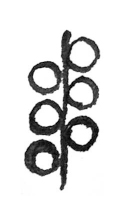
attach them by pins in alternate order of to the opposite edges of a long stretched india-rubber band, the elastic contraction of which is to do duty for our supposed force of longitudinal compression. Now give the band a very slight twist, (to determine the direction of twist in the subsequent contraction) and relax tension:— the two rows of spheres will roll up into a tight complex order, See page 15. Fig. I.10 which, if the spheres are in close contact with the axis, will be nearly the order , plainly tristichous,11 with three very steep spirals; and if the spheres are set a little away from the axis, the order becomes condensed into with wonderful precision and stability. (It is really startling to see the original two rows flash in an instant into a perfect 5-ranked model of an oak-bud, as it were, which can then be thrown about the room without dislocation of any of its members.) In the model it is easy to see that further contraction, with increased distance of the spheres from the axis, will produce the orders , , &c. in succession; and that these successive orders are successive maxima of stability; but the limits of the elasticity of our band make it difficult to realize the higher condensations.
It is also easy to see in the model, that the necessary sequence of these successive steps of condensation, determined by the geometry of the case, does necessarily exclude the non-existent orders , , , &c.
Perhaps the following figure will aid in setting forth these important points.
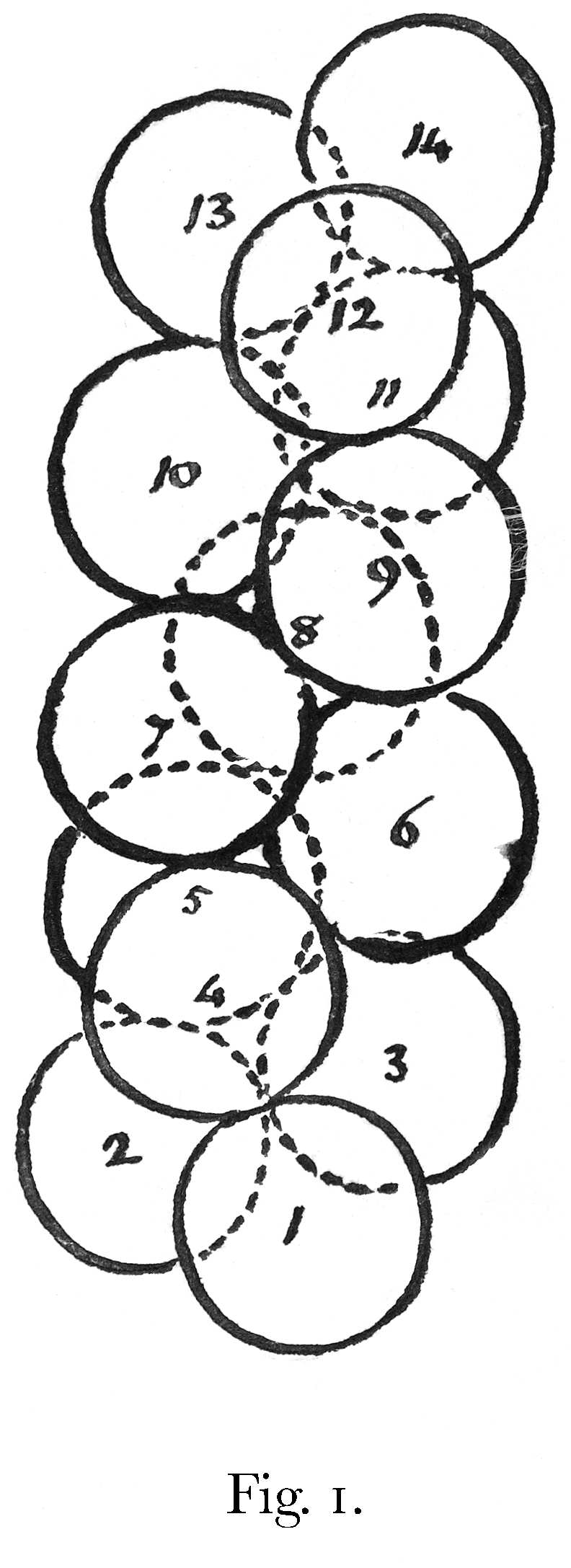
Fig I is a drawing of the complex order assumed by our two rows of oak-galls, when in close contact with the axis, as described on p. 13.12
The three steep spirals there mentioned are 1, 4, 7, 10, 13: 2, 5, 8, 11, 14: and 3, 6, 9, 12. (This is the nearest approach to the order that can be obtained by mere vertical contraction from an original order . To make these three ranks accurately vertical, we must have the agency of some auxiliary force, which may be advantage in respect of nutrition enjoyed by leaves in the same vertical rank, (an advantage which Mr. Chauncey Wright regards as all-important in fixing the cyclic feature in leaf-orders,) or, more probably I think, may be advantage of protection and co-adaptation between successive leaves in the same vertical, while in the bud,—the mid-rib of every leaf lying in the trough prepared for it by the inward fold of the leaf below.)
The two original ranks have become the spirals 1, 3, 5, 7, 9, 11, 13: and 2, 4, 6, 8, 10, 12, 14.
Now let us see what must happen under further longitudinal contraction.— Contraction cannot take place without some increase of girth: the spheres (which we take to represent mobile leaf-germs in the forming bud) must be pushed outwards from the axis (the bud-stem growing thicker as it grows shorter,) just so far as to accommodate the descent of their fellows above. Then it is plain that Nos. 6 and 1 will squeeze together between 3 and 4, and will found an approximately vertical rank: 9 and 4 will found a second: 7 and 2 a third: 10 and 5 a fourth: and 8 and 3 a fifth: and thus we shall have a new system with five ranks, the order, the most compact and stable and prevalent of all.
Under still further compression or contraction, 6 will slip away to the right of 1, and 4 to the left, and 9 will descend between 6 and 4 onto 1:— a similar process goes on all round; and the result is again a new system, with eight ranks, in order .
The next stage of compression will bring down 14 between 9 and 6 onto 1, and will produce the order .— It must be remembered that the first stage of compression would bring 14 onto 9 (order ); and the next would bring 14 onto 6 (order ); while at the same time 9 (side by side with 6) has descended upon 1; and then the meeting of 14 and 1 between 9 and 6 is seen to follow at once in the third stage.
In like manner, the fourth stage would produce the order : but this is beyond our figure.
—Now for the exclusion of non-existent orders.— It is evident in our figure (I) that no amount or degree of compression will avail to bring No. 5 down upon No. 1— That is, we cannot have an order .
No. 8 cannot come down onto 1: it would slip between 5 and 6 onto 3, with 6 and a lower one between 1 and 3. That is, we cannot have an order or .
No. 10 will descend upon 5, and then upon 2, but not upon 1. So we cannot have .
No. 12 will slip onto 4, as 9 onto 1, to make the order, and in the next stage 12 will slip between 4 and 7 onto a lower one, (as 14 between 6 and 9 onto 1) to make the order. So we cannot have a stable order .
In short, the only stable orders which will arise by compression of the system shown in Fig. 1. are those defined by the convergent series (..): , , , &c.: and these are the very orders that have long been recognized as occurring in nature. Surely this is more than a coincidence.
At any rate it is proved that the less simple orders do admit of formation from a pre-existing order by force of longitudinal contraction.
8. To illustrate the possible derivation of the whorled orders from an original distichous order (not alternate, but opposite or collateral,) we require another model, with the two rows of oak-galls arranged thus
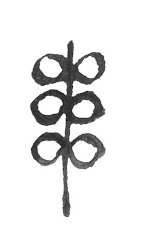 along the band.— Relax tension, and the system contracts into the crucial or opposite order with perfect accuracy, and perfect stability.
along the band.— Relax tension, and the system contracts into the crucial or opposite order with perfect accuracy, and perfect stability.
Whorls of 2 are found passing into whorls of 3 in fuchsia, sycamore, lilac, maple &c. (especially in shoots growing from a stump or stool).
Whorls of 3 are found passing into whorls of 4 in lemon scented verbena.
Hence it appears that whorls of 2 involve those of 3 and 4; and I think experiment would/will show that the transition was/is easy under longitudinal compression with due distance of the spheres from the axis, but I have not yet pursued the experiment so far.
We naturally ask, why have we no surviving instance of the distichous collateral order, as we have of the distichous alternate? I think the answer will be found in the manifest instability of the former, compared with the latter.
The former, under a force of longitudinal contraction, will pass into the crucial order13 (nettle, ash, &c); and, under a force of lateral pressure, will pass into the distichous alternate, the members of one row finding accommodation in the intervals of the opposite row: the distichous collateral order has no economic value in its own right, but only in subservience to one of those two, the crucial or the alternate, according as the pressing need is one of longitudinal or of lateral economy. The distichous alternate order, on the contrary, is manifestly stable and economical under lateral pressure, and to this advantage I believe it owes its survival. What happens to it under a superior force of longitudinal contraction, I have already considered, and have shown that the whole of the spiral orders may have had their origin thereby. In that part of my subject I had to confine my attention to the need of longitudinal contraction: but in a general view of all leaf orders we must recognize that the need is, in general terms, a need of economy of space, a need of contraction in the bud in all its dimensions: this need of general contraction resolves itself into two forces, one longitudinal, the other lateral, (a force of contraction and a force of constriction,) opposing one another and balancing one another, according to the demands of the slowly varying conditions of life. The shape of the bud is the visible expression of this equilibrium between these two forces; and according as one or the other prevails, so will the embryo leaves be arranged in few ranks (2 or 3) in a long narrow bud or in many ranks (5, 8, 13, 21 &c) in a short thick bud. Compare the need of lateral economy in crowded grasses, with the need of longitudinal economy in the winter-braving wind-bitten bud of our English oak.
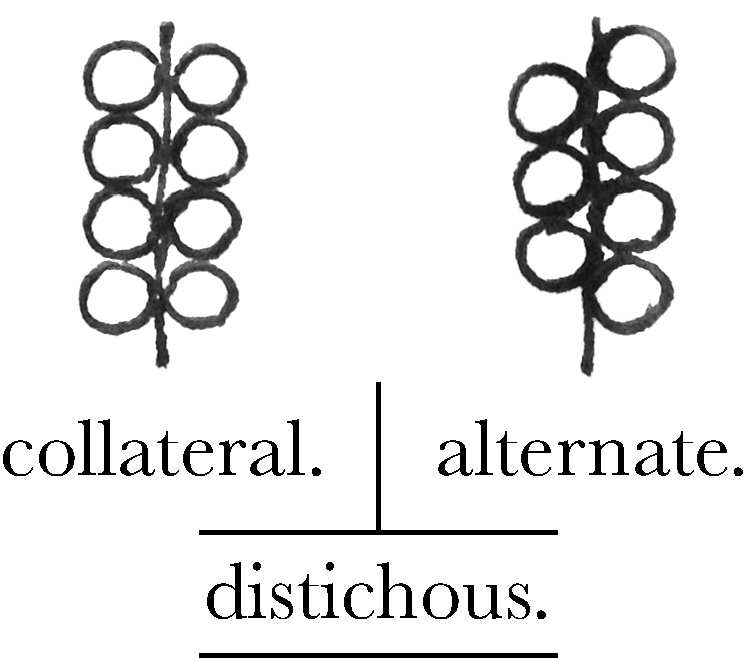
(Looking at Fig I, (p 15.)14 we see that 4 is not exactly over 1, but a little to the left—and after the first stage of contraction, 6 will not be exactly over 1, but a little to the right (because it has to squeeze between 4 and 3, and 4 is higher than 3). So after the 2nd. stage of contraction, 9 will not be exactly over 1, but a very little to the left.— And so on, through successive stages.
Now, I have considered, in the case of , how some other utility than that of contraction might step in to ensure exactly vertical ranks: but I think we very often find that very inexactness remaining uncorrected in nature. I venture to say that it is difficult to find a specimen that is exactly in order , or exactly in order , &c.— Again and again I have found myself baffled in trying to assign its proper order to a plant, and have been obliged to content myself with calling it “nearly” or “nearly.”— see how generally the five ranks of the oak-bud present a decided twist: and the oak-bud is strikingly regular. Surely these facts support the views put forward.)
To sum up, I suppose first, as the original of all existing leaf-orders, a distichous arrangement, somewhat irregular (Fig. II. a. resolving itself into two regular modifications, the alternate b. and the opposite (or collateral) c. From the former are derived all the alternate or spiral orders, and from the latter, all the whorled orders.
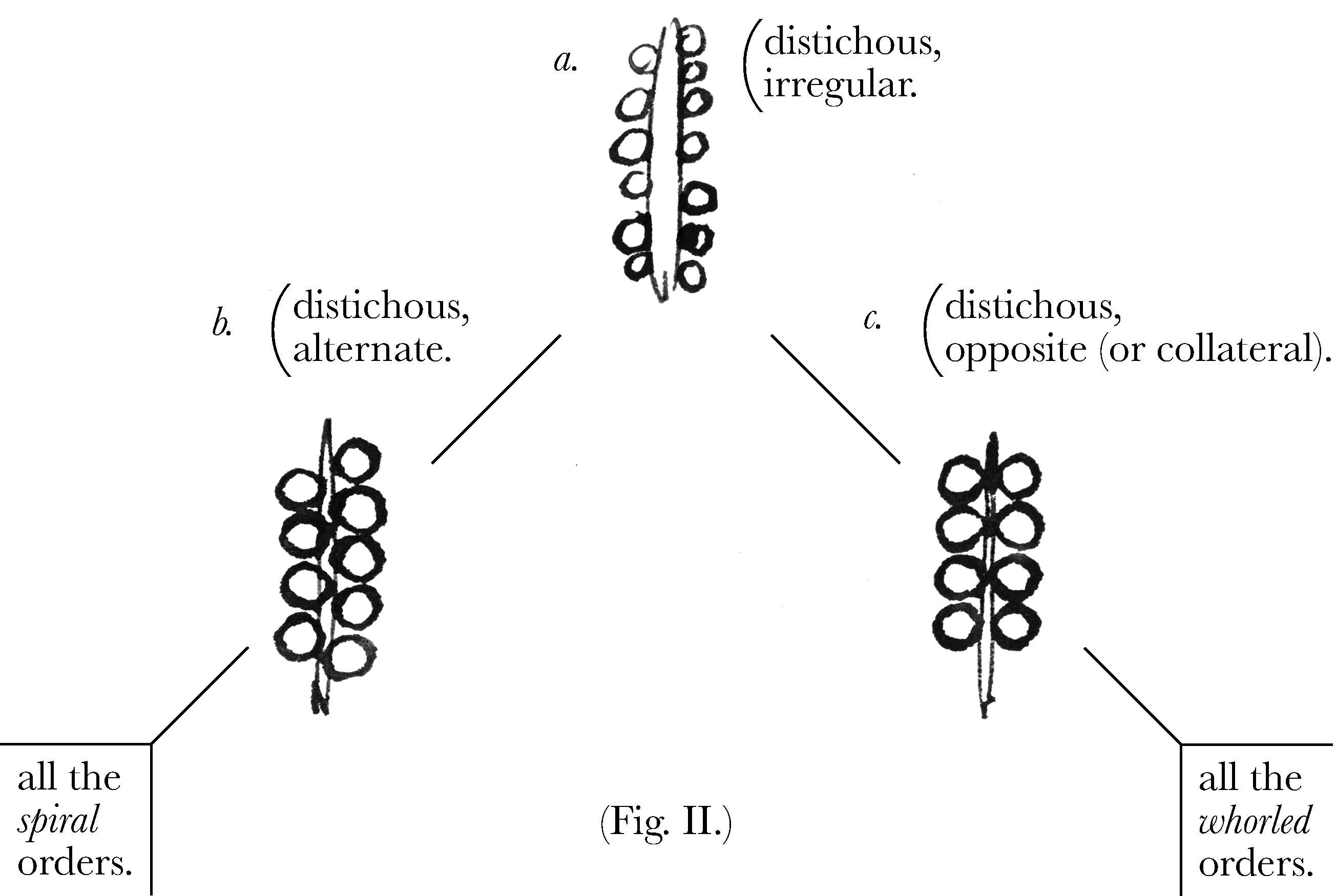
Beyond the scope of the present inquiry, but suggested by it, are questions concerning the nature of leaves and their relation to the stem from which they spring and to the bud-axis which supports them.
Leaves sometimes produce buds at their edges, at the tips of their veins, as in the “tree of life.” (I have not seen a “tree of life”, but only one of its leaves, and am assuming that its leaves are not such false leaves, real stems, as those of the butcher’s broom.)15 The modified leaves which form the carpels in the fruit of plants produce ovules at their edges.— Have we, in these facts, a hint that the original form of vegetable life was nothing more than a leaf, bearing young leaves at its two edges, and therefore naturally in distichous order? How often the veins of leaves are alternate!
Is the ovule a leaf, with the gift of marginal gemmation and continuous elongation?
Is the bud a leaf, with the same gift, under protection of a barren foster-leaf?
Is every twig a leaf, augmented by the roots of the leaves it bears?
Is the whole tree nothing but a leaf, made huge by the persistent roots and bones of all its progeny?
I do not know if these questions have been asked and answered already. I do not see how the tree is to be understood, unless they are all answered in the affirmative: though, as they stand, with so little support, I fear you will condemn them as very wild.— In that case I must fall back on my previous pages, and hope for your favourable opinion on the narrower ground of leaf-order rather than the wider field of leaf-nature.
Believe me, my dear Sir, with great respect, | Yours very sincerely | Hubert Airy
Charles Darwin Esqr. M.A., F.R.S., F.L.S. | &c. &c.
P.S. I hope I may have an opportunity some day of showing you the behaviour of my models—16
CD annotations17
Footnotes
Bibliography
Airy, Hubert. 1873. On leaf-arrangement. Abstract. Communicated by Charles Darwin. [Read 27 February 1873.] Proceedings of the Royal Society of London 21 (1872–3): 176–9.
Correspondence: The correspondence of Charles Darwin. Edited by Frederick Burkhardt et al. 29 vols to date. Cambridge: Cambridge University Press. 1985–.
Jackson, Benjamin Daydon. 1900. A glossary of botanic terms: with their description and accent. London: Duckworth & Co. Philadelphia: J. B. Lippencott Company.
Kuhlemeier, Cris. 2007. Phyllotaxis. Trends in Plant Science 12: 143–50.
Meehan, Thomas. 1871. [Observations on buds of Fraxinus quadrangulata.] [Meeting of 2 May and 3 October 1871.] Proceedings of the Academy of Natural Sciences of Philadelphia 23: 110, 245.
OED: The Oxford English dictionary. Being a corrected re-issue with an introduction, supplement and bibliography of a new English dictionary. Edited by James A. H. Murray, et al. 12 vols. and supplement. Oxford: Clarendon Press. 1970. A supplement to the Oxford English dictionary. 4 vols. Edited by R. W. Burchfield. Oxford: Clarendon Press. 1972–86. The Oxford English dictionary. 2d edition. 20 vols. Prepared by J. A. Simpson and E. S. C. Weiner. Oxford: Clarendon Press. 1989. Oxford English dictionary additional series. 3 vols. Edited by John Simpson et al. Oxford: Clarendon Press. 1993–7.
Tennyson, Alfred. 1859. Idylls of the king. London: E. Moxon.
Summary
Outlines his theory on the origin of existing orders of leaf arrangement. Believes spiral and whorled orders have evolved from a primitive distichous arrangement. These arrangements permit a compact bud form of small surface area that can withstand external changes in temperature, and in particular can tolerate frost.
Letter details
- Letter no.
- DCP-LETT-8412
- From
- Hubert Airy
- To
- Charles Robert Darwin
- Sent from
- Blackheath
- Source of text
- DAR 159: 16
- Physical description
- ALS 24pp damaged †
Please cite as
Darwin Correspondence Project, “Letter no. 8412,” accessed on 16 April 2024, https://www.darwinproject.ac.uk/letter/?docId=letters/DCP-LETT-8412.xml
Also published in The Correspondence of Charles Darwin, vol. 20


